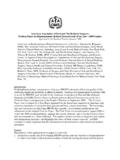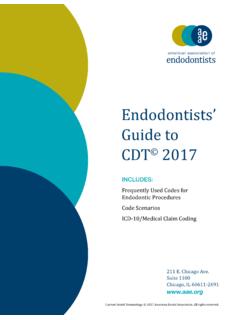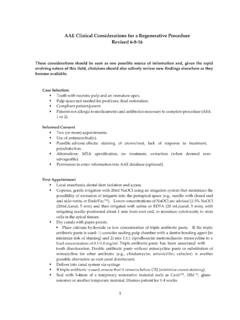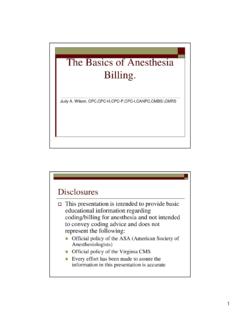Transcription of Treatment Standards - American Association of Endodontists
1 180 N. Stetson 1500 Chicago, IL e at ment StandardsAccess additional resources at is the branch of dentistry that is concerned with the morphology, physiology and pathology of the human dental pulp and periradicular tissues. Its study and practice encompass the basic clinical sciences including biology of the normal pulp, and etiology, diagnosis, prevention and Treatment of diseases and injuries of the pulp and associated periradicular tissues as defined by The American Dental Association and American Association of American Association of Endodontists serves as a trusted and credible source for information on diagnosis of pulp and periapical pathosis, Treatment planning, urgent/emergent Treatment , vital pulp therapy.
2 Nonsurgical root canal Treatment , surgical endodontics, regenerative endodontic procedures, and outcome assessment. Treatment by the general dentist is expected to meet minimum Standards as set out in guidelines. The American Association of Endodontists has developed and published as Standards of Practice . These guidelines were developed to assist educational institutions and organized dentistry in developing minimum educational requirements and practice Standards in endodontic Treatment . The primary objective of endodontic Treatment is to prevent and intercept pulpal/periradicular pathosis and to preserve the natural dentition when affected by pathosis.
3 The practice model in the United States is predicated on general dentists having the basic knowledge and experience regarding endodontic Treatment to perform the majority of nonsurgical root canal procedures on uncomplicated permanent teeth. Despite similar predoctoral educational curricula, disparities exist in the levels of knowledge, competency and skill, and clinical experiences of general dentists . Over the past two decades there have been significant advances in technology, materials and endodontic Treatment procedures.
4 These include but are not limited to microscopy, rotary Ni-Ti files, ultrasonics, enhanced irrigation solutions and technologies, digital radiography, CBCT three dimensional imaging, bioceramics, etc. These changes have created a disparity in the quality of care provided by specialists versus general dentists on teeth with complicated anatomy and effect of these developments on the Standard of Care remains unknown. Currently general dentists perform approximately 75% of all nonsurgical endodontic procedures. While Endodontists perform only 25% of the total root canal procedures, they treat 62% of the molars.
5 With generalists performing the majority of the uncomplicated anteriors and premolars it appears that the predoctoral educational process and procedures in general practice should be concentrated on uncomplicated permanent teeth with specialists treating the more complicated is based on a thorough understanding and interpretation of all diagnostic information including patient history, clinical and radiographic examination. Following the establishment of a diagnosis, Treatment planning should consider the following patient modifiers: the strategic importance of the tooth/teeth being treated, the periodontal status, structural integrity and restorability of the tooth, the long term prognosis for success, and patient factors such as the medical status, attitude and desires, motivation, anxiety, jaw opening, the gag reflex, disease state, and financial Standards | Page 3 The scope of endodontics in general dentistry includes.
6 Differential diagnosis and Treatment of pain and/or swelling of pulpal and/or periradicular origin Urgent/emergent Treatment of pain and/or swelling to include the pharmacologic use of antibiotics, anti-inflammatory agents, analgesic drugs and incision for drainage of localized abscesses Urgent/emergent management of traumatic injuries to the dentoalveolar structures Vital pulp Treatment to include step-wise caries excavation, indirect and direct pulp capping, and pulpotomy procedure Non-surgical root canal Treatment for the permanent dentition Bleaching of discolored dentin and enamel of teeth Treatment procedures such as post and/or cores involving the root canal space Standard of PracticeGeneral dentists should provide endodontic Treatment consistent with contemporary endodontic Standards , their knowledge and clinical experience, and technical skills.
7 The Standards of practice are constantly changing based on new evidence and technology. It is the responsibility of all practitioners to be life-long learners, in order to meet contemporary is a critical component of life-long learning. The generalist should be able to critically evaluate their own competency as diagnosticians and clinicians and identify areas that require additional educational experiences. Based on this evaluation each practitioner must be able to determine their own skill and learning in order to determine when the patient should be referred to the appropriate specialist for of traditional education and the emphasis on facts are changing.
8 Information technology has transformed the dental profession and placed emphasis on the evidence based practice model. Contemporary methods of education emphasizing problem solving and critical thinking skills employ and stress professional interactions and the benefits of multidiscipline and interdisciplinary Case Difficulty Assessment FormFollowing examination and testing, a diagnosis is established, a Treatment plan is formulated, and the prognosis determined. The general dentist then must determine the degree of difficulty and associated risks.
9 The AAE Case Difficulty Assessment Form provides a national protocol for accomplishing this assessment. There are many factors that influence degrees of difficulty and risk of endodontic Treatment . Recognition of these factors prior to the initiation of Treatment helps practitioners to understand the complexities that may be involved in individual cases and prevents adverse outcomes due to avoidable procedural errors. In determining the degree of difficulty, a general dentist should not undertake Treatment of a case unless he/she is prepared to also manage complications that may arise in additional resources at for Using the AAE Endodontic Case Difficulty Assessment FormThe AAE designed the Endodontic Case Difficulty Assessment Form for use in endodontic curricula.
10 The Assessment Form makes case selection more efficient, more consistent and easier to document. dentists may also choose to use the Assessment Form to help with referral decision making and record listed in this form should be considered potential risk factors that may complicate Treatment and adversely affect the outcome. Levels of difficulty are sets of conditions that may not be controllable by the dentist. Risk factors can influence the ability to provide care at a consistently predictable level and impact the appropriate provision of care and quality Assessment Form enables a practitioner to assign a level of difficulty to a particular of DifficultyMINIMAL DIFFICULTY Preoperative condition indicates routine complexity (uncomplicated).









